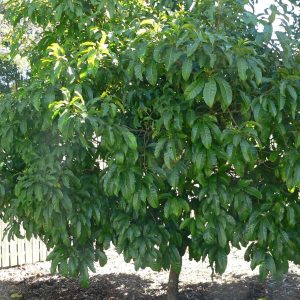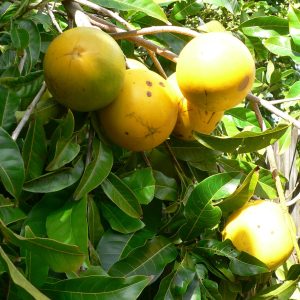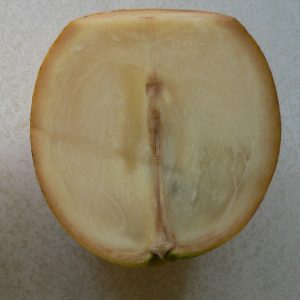Lucuma (Pouteria)caimito
Abiu
Origin
The Amazon valley of South America.
Climate
Lowland humid tropical or subtropical. Matured trees can tolerate light frosts. Evenly distributed light rainfall or irrigation of 1000 – 3000 mm per year, a latitudinal limit of 20o from the equator. Short periods of water stress can be tolerated, but may be detrimental to the size and quality of the crop
Plant Description
The abiu is a medium-sized, densely foliaged evergreen tree which can grow up to 15 m in height under ideal conditions.
Relatives
Sapotaceae Family, related to canistel, star apple, mamey sapote, green sapote.
Soils
Suited to a range of soils, but prefers a mildly acid, rich clay loam with good drainage. It suffers chlorosis in limestone soils and does not tolerate saline or waterlogged soils. Has a particular need for zinc and potassium; the latter case can be met with a 1% potassium nitrate foliar spray in early winter.
Propagation
Seeds, grafts, cuttings and marcots. Seedling behavior is variable..
Cultivars
Inca Gold,Cape Oasis, Gray, Z1, Z2, Z3, Z4, T25 and T31.
Flowering and Pollination
Flowering can occur two or three times a year. The small, white flowers occur on new growth and are usually selfpollinating. Pollination is dependent on high relative humidity and insects, eg. bees, flies, ants and various butterflies. Low humidity and windy conditions are harmful to flowering, pollination and fruit set. It has been suggested that applications of boron and magnesium sulfate (Epsom Salts) several months before flowering can encourage fruit set. It takes about three months from flowering to fruit ripening.
Cultivation
Can be planted closely in a sunny position and windbreaks are very helpful. WA’s hot, dry summer sun can cause scorching of foliage. Keep weeds controlled to reduce competition, especially when trees are young. Constant water is required during fruit growth, or fruit will split during rapid maturation. Trees respond well to constant feeding with organic manures and mulch.
Wind Tolerance
Moderately resistant to wind damage. Can reshoot after being damaged or broken off by severe storms (grafted scions may be lost).
Pruning
Prune to a small, bushy shape – it sunburns easily. Begin pruning when the tree is young to develop a good tree shape. Strong pruning is essential and results in fewer, but stronger, branches to hold the fruit crop. A single trunk is best, with the lowest branches at least 1m from ground level. Remove any suckers and dry panicles.
The Fruit
Can be variable in shape, but fruits are usually oval with a smooth, waxy yellow skin containing latex before full maturity; a small nipple may be found at the apex. Size can be up to 15cm in diameter with white, juicy, sweet flesh. The flesh is sweet and may be firm or soft. A large fruit can reach 750g. Inside are 1 to 5 seeds.
Fruit Production and Harvesting
Can begin producing flowers and fruit as young as two years, and may have two or three flowering/fruiting cycles in a year. A mature tree can produce 200 kg per year. Fruit turns yellow before ripening; full maturity takes a further 8 or 9 weeks. Fruit are mainly harvested in late summer. Fruit bruises easily and for marketing purposes should reach the market within 5 days of harvest. There is a short shelf life.
Fruit Uses
Usually used fresh, out-of-hand, or in fruit salads, ice creams and added to yogurt.
Pests and Diseases
Fruit fly, fruit piercing moths, thrips, scale, and birds. Bagging (paper or cloth bags) is a good way to protect the fruits: they fall off into the bag when mature.
Comments
Most people who taste Abiu like it very much. It can be eaten with a spoon and latex is not a problem in properly ripe fruit. The thick rind, which is not eaten, oxidises rapidly once fruit is cut.


